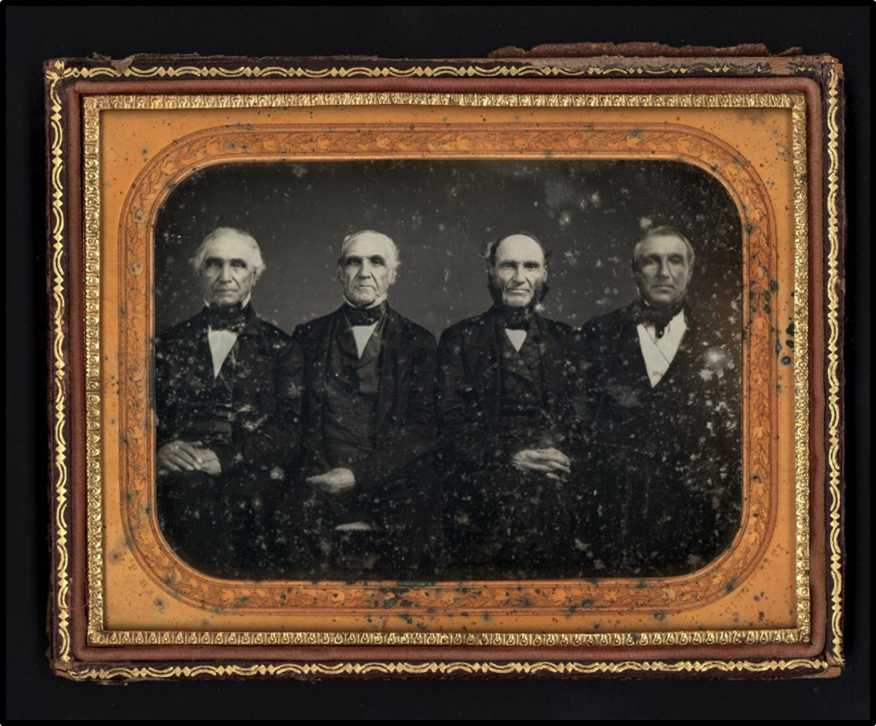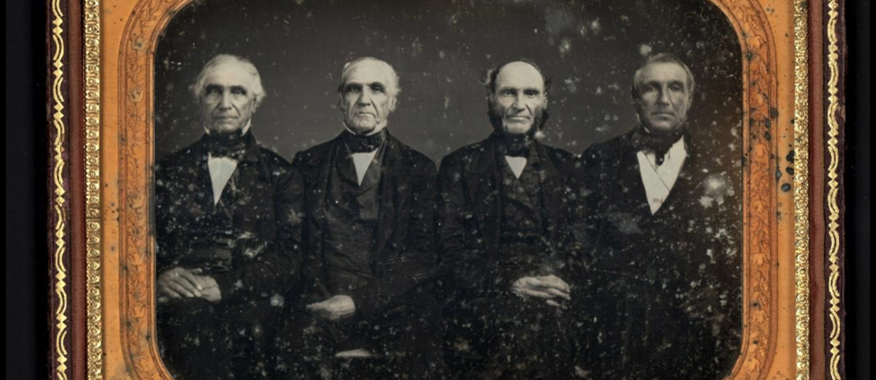
CMC Blog
Early Photography – Part 1 of 4
Daguerreotypes
By: James DaMico, Curator of Audiovisual Collections
The daguerreotype was invented by Louis Jacques Mandé Daguerre and was introduced to the French Academy of Sciences on January 7, 1839. A silver-plated copper plate is polished on the silver side to a mirror-like sheen and exposed to iodine vapor. A latent image forms after exposure to light in the camera, and the image is developed with heated mercury vapor, fixed then rinsed. They were put behind glass and sealed with paper tape so air cannot tarnish the plate and then put into a small hinged case.

Portrait of Four Prominent Unidentified Men.
J.P. Ball Collection (SC#17)
Ca. 1850
½ plate daguerreotype (4 1/4" x 5 1/2 ")
What we see here is a ½ plate daguerreotype (measuring 4 ¼ x 5 ½ inches) that was taken by J.P. Ball, a successful African American photographer who practiced in Cincinnati from 1849-1871. His name is embossed on the mat in the lower left corner.
The easiest way to tell if you have a daguerreotype is to see if it has a reflection like a mirror. You have to tilt it back and forth to see the image.
Some of the well-known daguerreotypists working in Cincinnati were Ezekiel C. Hawkins, who is believed to have established in 1840 the second daguerreotype gallery in the United States; Thomas Faris, who is attributed with introducing the daguerreotype to Ohio and owned the Melodeon Gallery from 1844-1857 ; and Charles Fontayne and William Southgate Porter, who in 1848 made an eight whole-plate panoramic daguerreotype of Cincinnati waterfront which is owned by the Public Library of Cincinnati and Hamilton County. Their gallery and studio was located at 30 West Fourth Street between Main and Walnut Streets and charged from $2 to $20 for a picture depending on the size, style, case or frame.
The daguerreotype, a one of kind photograph, was popular from about 1840-1855 and was replaced by the cheaper to produce ambrotype (1855-1865). This was followed up by the tintype (1856-1900), Carte-de-Visite (1860-1900) and Cabinet Card (1866-1900s).
The Photography Department of Cincinnati Museum Center holds over one million photographic prints, negatives, slides, glass plate negatives and cased images such as daguerreotypes.
1 Gagel, Diane VanSkiver. 2013. Ohio photographers: 1839-1900.. Page 14
Museum Admission
Includes Cincinnati History Museum, Museum of Natural History & Science and The Children's Museum
| Adult: | $22.50 |
| Senior: | $15.50 |
| Child: | $15.50 |
| Member Adult: |
FREE |
| Member Child: |
FREE |
Members receive discounts!
Become a Member today to save on programs, exhibits and films throughout CMC.
Museum Hours
Open Thursday – Monday
10 a.m. to 5 p.m.
Closed Tuesday and Wednesday
Closed Thanksgiving Day and Christmas Day
Member’s-only early entry: Saturdays at 9 a.m.
Customer Service Hours:
Monday – Sunday, 9 a.m. to 5 p.m.

